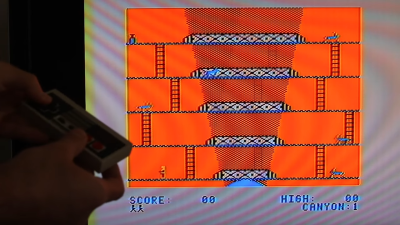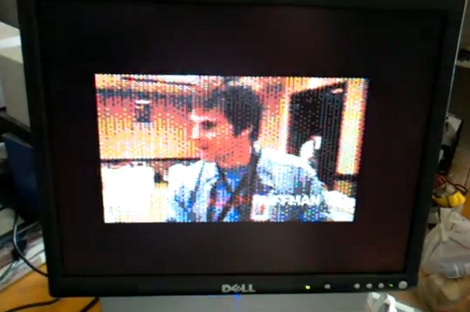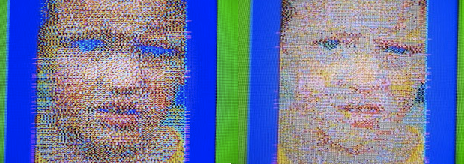After a quiet week in the news cycle, surveillance concern Flock jumped right back in with both feet, announcing a strategic partnership with Amazon’s Ring to integrate that company’s network of doorbell cameras into one all-seeing digital panopticon. Previously, we’d covered both Flock’s “UAVs as a service” model for combating retail theft from above, as well as the somewhat grassroots effort to fight back at the company’s wide-ranging network of license plate reader cameras. The Ring deal is not quite as “in your face” as drones chasing shoplifters, but it’s perhaps a bit more alarming, as it gives U.S. law enforcement agencies easy access to the Ring Community Request program directly through the Flock software that they (probably) already use.
color computer4 Articles
Adapter Lets Digital Gamepads Work On The Tandy Color Computer
The Tandy Color Computer came with analog joysticks, quite unlike most computers and consoles of the early 1980s. Many games of the era actually worked best with digital input, so [Gadget Reboot] whipped up a converter board to allow Nintendo gamepads to work with the computer.
 The build relies on an earlier breakout board that [Gadget Reboot] built in order to read early Nintendo gamepads and output a digital 5 V signal. Meanwhile, the Tandy Color Computer is expecting variable o-5 V signals from the X and Y axis pots in its standard joysticks. To convert the gamepad button presses into voltages for the CoCo, the build uses a CD4066 analogue switch IC. When no controller buttons are pressed, the 4066 is set up to output 2.5 V on both the X and Y axes. Pressing up or down, or left or right on the D-pad, outputs 0 V or 5 V respectively as required. This essentially lets the controller’s D-pad act as a digital joystick for a computer that never actually had one.
The build relies on an earlier breakout board that [Gadget Reboot] built in order to read early Nintendo gamepads and output a digital 5 V signal. Meanwhile, the Tandy Color Computer is expecting variable o-5 V signals from the X and Y axis pots in its standard joysticks. To convert the gamepad button presses into voltages for the CoCo, the build uses a CD4066 analogue switch IC. When no controller buttons are pressed, the 4066 is set up to output 2.5 V on both the X and Y axes. Pressing up or down, or left or right on the D-pad, outputs 0 V or 5 V respectively as required. This essentially lets the controller’s D-pad act as a digital joystick for a computer that never actually had one.
It’s a neat hack that might make playing certain games on the Color Computer significantly easier. It’s also just neat to interface a different controller to the old hardware. In the early 80s, computers were simple enough that this could all be achieved with a minimum of dumb circuitry.
Continue reading “Adapter Lets Digital Gamepads Work On The Tandy Color Computer”
Giving The TRS-80 CoCo A 44 Color Display
As a relic of the early 80s, the TRS-80 Color Computer couldn’t display very many colors. By default, the CoCo could only display 8 colors on the screen at a time, but [John] figured out a way to increase the number of colors displayed using a very simple trick that surprisingly isn’t found in original CoCo games.
The TRS-80 Color Computer uses a Motorola 6847 video display generator to produce color graphics on its display. There are several graphics modes available to CoCo programmers, including a high-resolution black and white mode, and two four-color modes using red, green, blue, and yellow or buff, cyan, magenta, and orange.
These color palettes are extremely limiting, and usually switching between these modes produces a lot of flicker. [John] figured out if he switched the color pallets every 1/60th of a second (i.e. during the vertical blanking interval), he could display 44 colors on the CoCo.
It’s a clever little hack to increase the color palette of the CoCo, and in our opinion should be in the running for winning this season’s Retrochallenge. Sadly, [John] is judge for the Retrochallenge this time around, so he’ll have to settle for earning a Hackaday merit badge.
Tandy Color Computer (CoCo3) Color Video Playback

[John W. Linville] wrote a digital video player for the Tandy Color Computer (aka TRS-80). The decades-old hardware performs quite well considering the limited resource he had to work with. This is the second iteration of his player, and can be seen after the break playing a promo video for CoCoFEST 2011 where he’ll show it off in person.
In the most recent thread post (at the time of writing) [John] shares the methods used to get this running. FFMPEG is used on a modern computer to process the source video by separating the audio into an 8-bit 11040Hz file, and it generates several PPM files with the proper video frame rate. ImageMagick takes it from there to convert the PPM files to a bitmap format. It also processes each frame for differential changes, reducing the size to fall within the available bandwidth. They are then interleaved with the audio to produce the final format. Video is 128×192 with rectangular pixels. [John’s] already used it to watch such classics as War Games on the antiquated hardware.
Continue reading “Tandy Color Computer (CoCo3) Color Video Playback”












